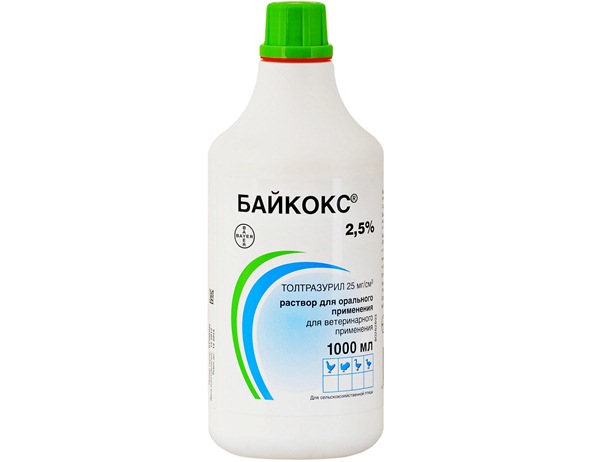When keeping birds it is necessary to take into account that they subjected to various kinds of infectious diseases. Therefore, from the very first days of life, prevention is done with the help of drugs intended to fight infections in poultry. One of the effective remedies is Baycox medicine.. It is used for prophylactic purposes, for the treatment of various infectious diseases in adults and in chicks. In order not to be mistaken in dosages and to know in which cases the agent should be used, it is worthwhile to get acquainted in detail with its characteristics and instructions for use.
Table of contents
For which diseases baycox is used
Medicine Baycox is used to treat coccidiosis in broilers, chickens, turkeys, geese, quails, ducks, pigeons and other poultry. It has an effect on coccidia of all kinds. Able to destroy even those strains and species with increased resistance to the effects of other drugs anti-bacterial type.
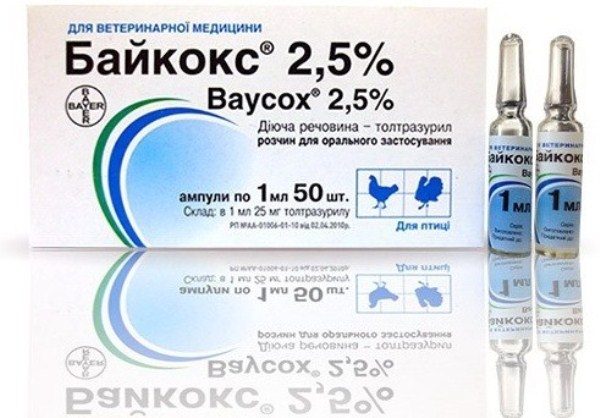
The main component is toltrazuril destroys pathogens during all stages of their development, as well as during intracellular development. In addition, when taking the drug does not decrease the immune system and the body resistance of individuals against coccidiosis. It is added with different types of feed or water. It can be combined with other medicines. A good result gives reception along with vitamin complexes.
What are the dosages and instructions for use
Medicine is given to birds if they have one. increased levels of coccidia in litter - 10-20 thousand / g. It is given during clinical signs of illness and as a preventive measure.
The drug is taken along with drinking water. Dose per 1 kg of the individual is 7 mg, per 100 kg 28 ml of a 2.5% solution of the drug. To 1 liter of water, add 1 ml of a 2.5% bikox solution. The bird sings with this amount of solution for about 2 days. It is possible to dilute 3 ml of a 2.5% solution of the medicine in 1 liter of water, only the rules of administration are different. This solution is given for 8 hours 2 days in a row. In severe forms of the disease, the medication is repeated after 5 days.
However, these are general reception guidelines for all types of birds. Still, you need to familiarize yourself with the rules of admission, both for young animals and for adults.
For chickens
Chick contentt - this is a troublesome thing, because they definitely need to create a comfortable environment and protect young animals from infectious diseases.
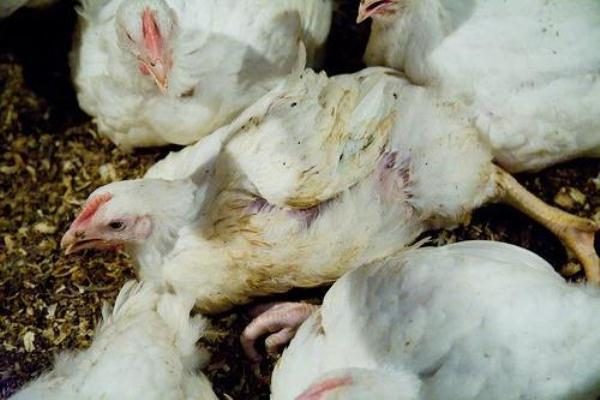
From two weeks of age chickens are exposed to these conditions and diseases, as:
- Indigestion. It uses glucose and probiotics;
- Weakness and retardation in development. In these cases, vitamin complexes are added to food;
- May be observed lack of oxygenpulmonary edema, ascites, growth retardation, fragility and fragility of bones. Antibiotics are given to prevent these problems;
- Viral pathologywhile they are being vaccinated;
- In this period chickens are susceptible to various forms of coccidiosis, from which the drug Baycox helps.
Medicine for the treatment of coccidiosis in chickens can be used in conjunction with other means of similar action. It is advisable to use it from two weeks of age of the bird. For chickens, the solution is prepared with water. At 1 liter of water is added 1 ml of the drug. The solution is given within 24 hours.
For goslings
In the first days of the goslings, infectious diseases occur, which, if not treated in time, lead to serious consequences, including the death of the young. This is all due to a weak immune system and low resistance to diseases. But it is worth noting that unlike chickens, goslings are much stronger and they have a much higher survival rate, but only with appropriate care.
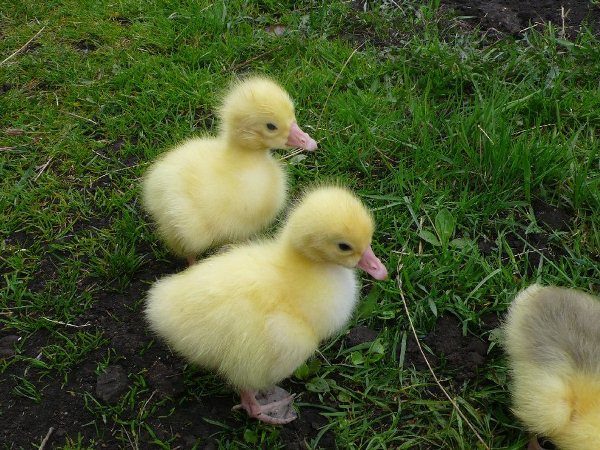
In the first days of life individuals should pay attention to the condition of chicks, monitor their development and health. Sure to from two weeks of age Prevention of infectious diseases, coccidiosis. At this time, goslings are given a bikox solution. The medicine is added to the water. For 1 liter of water you need 1 ml of 2.5% medication. This solution is given within 24 hours.
For poults
Poults from the first days of life need appropriate care. At this time it is necessary to assemble a complete first-aid kit, which must be included. the following types of drugs:
- Development boosters, growth and productivity of individuals;
- Preparations from fungal infections;
- Medicines for viral diseases (antibiotics);
- Probioticswhich are designed to boost the immune system;
- Vitamin and mineral complexesthat are added to food. These funds are necessary for young stock from the first days of life, because they contain all the necessary vitamins for the full development of turkey poults;
- Must be a drug baycoxwhich is necessary for the treatment of coccidiosis. It is worth noting that turkey poults are difficult to tolerate this disease, and if not treated, all livestock may die.
With coccidiosis in turkey poults there is a liquid feces with blood, weakness and poor appetite. When these symptoms occur, birds are given a solution with baicox. At 1 liter of water is added 1 ml of 2.5% medication. This solution is given within 24 hours.
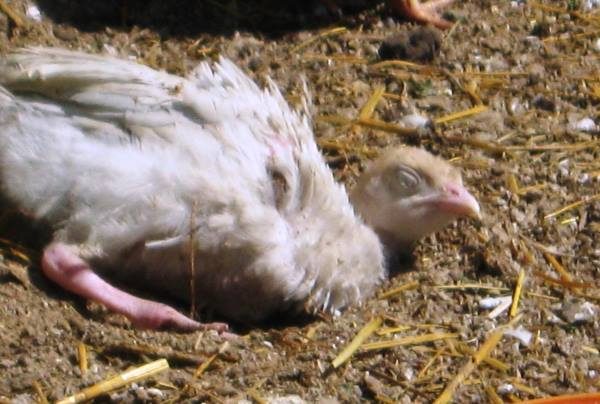
In the first 5-7 days, turkeys are given a solution with baycox for the prevention of coccidiosis. At 1 liter of water, add 1 ml of 2.5% funds. Birds are watered with this solution for 24 hours.
For other birds
For other types of chicks, such as ducklings, quails, pigeons, the rules for taking the drug are the same. During this period, it is necessary to give funds intended to strengthen the immunity of the young. Do not forget about the vitamin complexes that are needed for the full growth and development of individuals.
For the treatment of coccidiosis give baykoks, it is diluted in water. At 1 liter of water is added 1 ml of 2.5% medication. Chicks are watered with this solution for 24 hours. This solution is given for the prevention of coccidiosis.
For adult birds
For broilers
While reaching the maximum level of coccidia in the litter of 10-20 thousand / g, it is necessary to begin the treatment with Baycox medicine. He is bred in water. In 1 liter of water, you must add 1 ml of 2.5% medication. This solution is given during the day. It is possible to add 3 ml of 2.5% of the drug to 1 liter of water. It is given for 8 hours within 2 days.
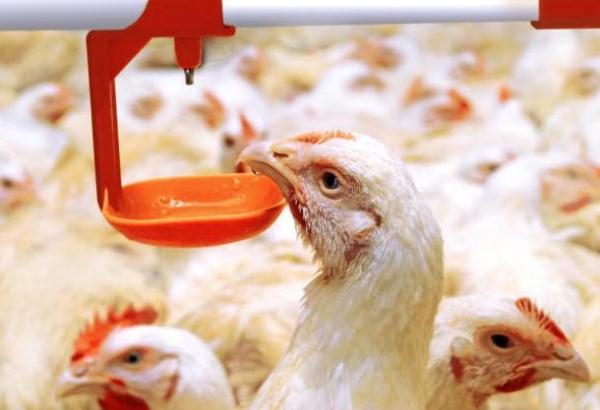
For preventive procedures for various forms of coccidia, the solution is prepared with water. This solution is used for feeding the bird for about a day or 2 days, depending on the dosage.
For others
For other types of birds - chickens, geese, ducks, turkeys, the rules for taking the drug are similar. It is given in coccidiosis, when the level of coccidia in the litter reaches its maximum level. It is diluted in clean drinking water. In 1 liter of water is added 1 ml of 2.5% medication. This solution is watered for sick individuals for about a day. It is also possible to add 3 ml of 2.5 products to 1 liter of water. Individuals are given this solution for 8 hours for two days in a row.
For prophylaxis diluted in 1 liter of water with 1 ml of 2.5% of the drug. This solution is given to birds for about a day.
Side effects
If you take the medication according to the instructions, then there will be no side effects from it. is he well tolerated by all types of birds, allergic reactions to it does not occur.
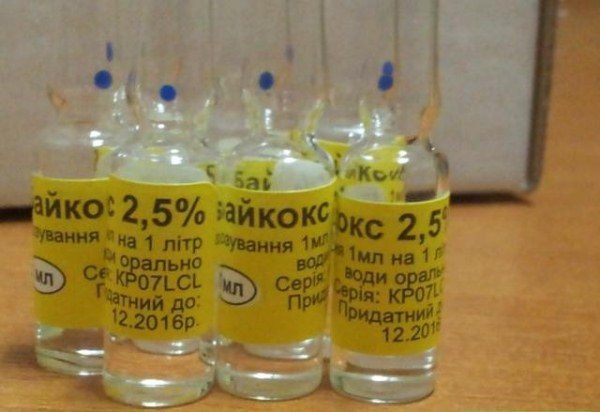
The drug belongs to the hazard class 4. From this it follows that even if the dosage will be 10 times higher than the prescribed dosage, the medicine will not have a side effect and will not harm life various types of birds, including young stock
Contraindications
Not recommended for laying hens. According to studies, the drug enters the composition of eggs. For laying hens, Bakox is given in extreme cases, but on condition that the eggs are not eaten during treatment.
Pharmacological properties
Baykoks is included into group of anticoccidian means. It has an active action against coccidia, namely, resistant to the effects of other anticoccidian drugs. Affects all periods of intracellular development of ameri.
Active ingredient - toltrazuril, when dropped into the body, has a blocking effect on the respiratory enzymes of coccidia and damages the methochondria, disrupts the processes of separation of the core of coccidia.As a result, there is a violation of the formation of macrogametocytes. After oral administration of toltrazuril, slow absorption occurs. this component and due to this coccidiocidal effect on the mucous membrane and submucosa of the gastrointestinal tract. Removal of the component from the body of birds occurs in unchanged form or in the form of metabolites with droppings.
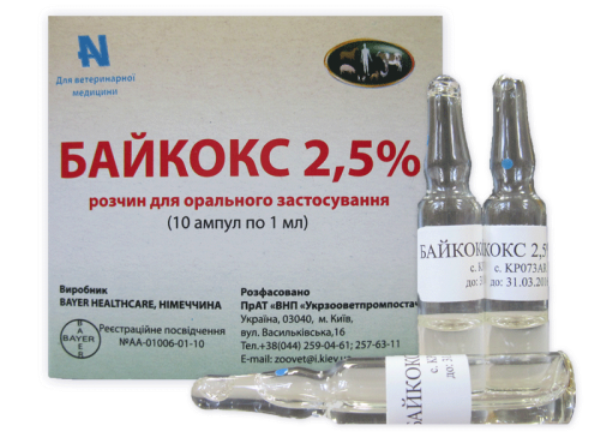
It has moderate toxic properties in relation to warm-blooded animals.. In moderate dosages, as well as 10 times the dosage, it does not cause side effects, does not cause allergies and complications. Does not reduce the immune system and the body's resistance to coccidiosis.
Coccidiosis in birds - This is a serious disease that affects the entire body. When the first symptoms of the disease appear, it is necessary to treat with the help of the drug bikox. This tool is capable of a short period to destroy infectious agents. It can be used for prophylaxis in both young and adult individuals.
